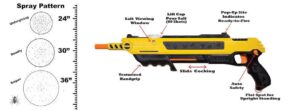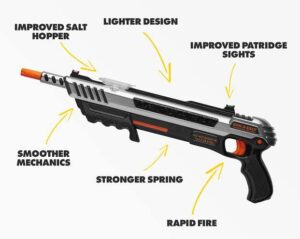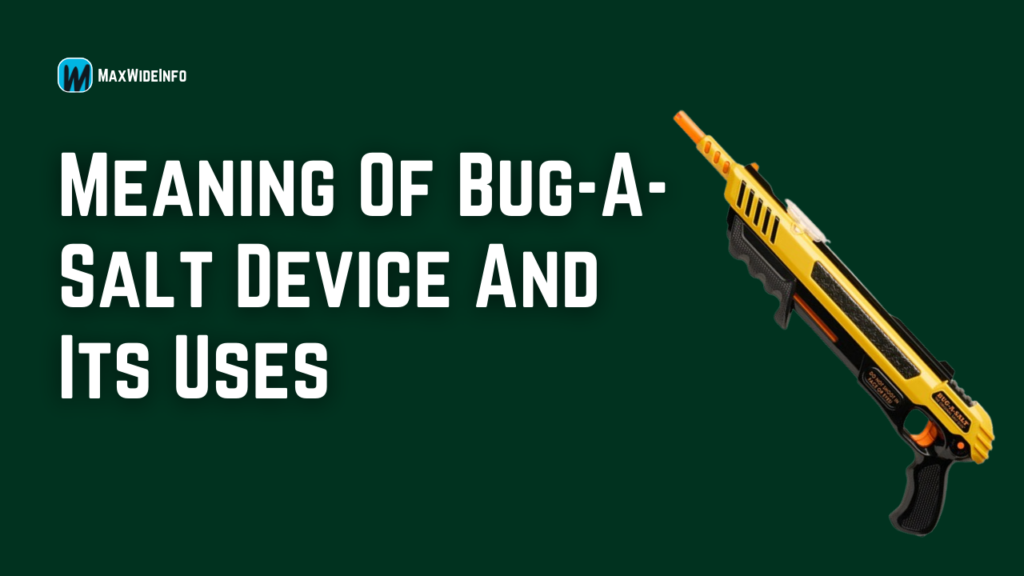If you’re tired of having pests around, especially flying ones like houseflies and mosquitoes, the Bug-A-Salt shotgun can help.
With this tool, you won’t need to spray your home with pesticides or apply repellent creams to avoid mosquito bites.
Using these chemicals can be harmful to your health and lead to long-term disease condition.
The Bug-A-Salt gun provides a safer alternative to chemical sprays, offering the same pest control without the negative side effects. It makes getting rid of insects fun, turning it into a game-like-world.
This article will explain what Bug-A-Salt is, how it works, its features, and answer some common questions people have about it. Read on carefully to learn more.
Brief History Of Bug-A-Salt Device?
Bug-A-Salt was created by Lorenzo Maggiore and got its patent in 2012. Maggiore made this tool to kill houseflies from a distance without making a mess.
The company Skell Inc launched Bug-A-Salt in 2012 on Indiegogo. By the end of their crowd-funding campaign on September 11, 2012, they had sold over 21,400 units of the original Bug-A-Salt salt gun.
What Are Bug-A-Salt Devices?
Bug-A-Salt is a plastic gun that kills soft- bodied insects by hitting them with salt particles.
The Bug-A-Salt device uses regular table salt as non-toxic projectiles to kill insects. The gun can shoot up to 80 times, spraying salt in a cone-shaped pattern, similar to a shotgun blast.
Bug-A-Salt is a unique tool for getting rid of insects. It shoots salt crystals at high speed, acting like tiny buckshot to knock
mosquitoes and other bugs out of the air. If you have a bug problem with flies, mosquitoes, or spiders, this table-salt shooting up offers a fun and effective way to deal with it. Just make sure you’re a good shot.
Description Of The Bug-A-Salt Gun?



The Bug-A-Salt shotgun consists of several key parts, each contributing to its functionality:
- Salt Reservoir: The compartment where you load the table salt. It typically has a lid or cap to keep the salt contained and dry.
- Cock Handle: A handle that you pull back to cock the gun. This action compresses a spring inside, preparing the gun to fire.
- Trigger: The mechanism you pull to release the compressed spring, which then propels the salt out of the barrel.
- Safety Switch: A safety mechanism that prevents accidental firing. It needs to be disengaged before the gun can fire.
- Barrel: The tube through which the salt is propelled when the gun is fired. It helps direct the salt towards the target.
- Pop-up Sight: Usually a simple aiming mechanism on top of the gun, allowing you to aim more accurately at the insect.
- Spring Mechanism: The internal component that gets compressed when you cock the gun. When you pull the trigger, the spring releases its stored energy to propel the salt.
- Nozzle: The end of the barrel where the salt exits the gun. It helps to focus the burst of salt for better accuracy and impact.
Keep In Mind That:
This is not the official description of the shotgun; it’s just my own perception and review based on what I observed. The image below provides the manufacturer’s official description.
How Does The Bug-A-Salt Gun Works?
The Bug-A-Salt shotgun operates by using table salt as a projectile to effectively kill small insects.
It works on a simple principle of compressed air generated by the spring mechanism, which propels the salt grains at high speed which is both effective and safe for indoor use.
Here’s a breakdown of how I think it works based on what I’ve observed:
- Loading: Fill the gun’s reservoir with regular table salt. Ensure you do not overfill to maintain proper functionality.
- Cock And Aim: Cock the gun by pulling back the handle. This action primes the internal mechanism, making it ready to fire. Aim at the target insect from a suitable distance (usually a few feet away).
- Firing: Release the safety and pull the trigger. The gun uses a spring-loaded mechanism to shoot a small burst of salt with enough force to kill or incapacitate small insects like flies.
- Repeat: After firing, the gun needs to be cocked again before it can shoot another burst of salt.
Installation And Callibration Of The Bug-A- Salt Beam Light
Installation
- Loosen the adapter screw
- Take the adapter ring even though it maybe tight, out the slipper on the tip of the gun’s nozzle and click it in
- Insert the bug beam, flip the gun over and tighten the adapter screw.
Calibration
The instructions broken down into steps:
- Prepare Materials: Gather a box, foil paper, tape, and a marker.
- Wrap the Box: Use the foil paper to wrap the entire box. Secure the foil paper in place with tape.
- Mark the Box: Use the marker to mark specific points on the box. These marks will help direct the beam and check its calibration.
- Check the Beam Calibration: Turn on the beam. If the beam is properly calibrated, you will see one straight red light. If the beam is not properly calibrated, you will see two points of red light instead of one.
- Adjust the Beam: Locate the two screws on the bug beam, one horizontal and one vertical. Use these screws to adjust and calibrate the beam until it produces a single straight red light.
Bug-A-Salt Code Of Conduct
They are:
- Do not point the BUG-A-SALT at anyone!
- Treat your BUG-A-SALT as a loaded firearm.
- Do not point the BUG-A-SALT at family pets! Your pets or anyone else’s pets.
- For use on pests and insects only!
- No butterflies, praying mantises, dragonflies, or the like are to be targeted with this device!
- Should only be used by adults of the age range 18 years and older.
Basic Care Tips For Your Bug-A-Salt Shotgun
Here are some basic care tips for your Bug- A-Salt shotgun to ensure it functions well:
- Cleaning: Regularly wipe down the exterior with a dry or slightly damp cloth to remove salt residue. Avoid using water or cleaning agents inside the gun.
- Storage: Store your Bug-A-Salt in a dry place to prevent salt from absorbing moisture, which can cause clumping and affect the gun’s performance.
- Loading: Use only the recommended type of salt, typically regular table salt. Avoid using larger grains or other substances that could clog the gun.
- Safety: Always engage the safety mechanism when not in use to prevent accidental firing.
- Unclogging: If the gun becomes clogged, follow the manufacturer’s instructions for safely clearing any blockages.
- Inspection: Regularly check for any signs of wear or damage, particularly in the moving parts, and replace parts as needed.
Conclusion
The Bug-A-Salt device is a non-toxic, salt- shooting gun designed to kill small insects, offering a safe alternative to chemical pesticides.
It operates through a spring mechanism that propels table salt to incapacitate pests.
The device is easy to use, fun, and requires basic maintenance for optimal performance. Always follow safety guidelines when using it.
FAQS
Can I use anything besides salt in the BUG-A-SALT?
No! Using other substances will damage your gun and void the warranty.
Is the gun dangerous?
No, unless misused. Don’t shoot anyone in the face or eyes. Treat it like any firearm. It won’t penetrate skin or damage furniture.
What kind of salt does it use?
Any ordinary table salt.
Will the salt splatter the bug?
No, the bug will stay whole for easy clean- up.
Can you provide parts so I can repair my gun?
Due to supply issues, we can’t offer replacement parts. There are repair videos on YouTube, but we are not connected to them and can’t supply parts.
How much salt does the gun shoot?
A pinch of salt.
What is the accuracy range of the gun?
Ideal within three feet. Practice by shooting aluminum foil to see the salt spray pattern.
How many shots before I need to reload?
The gun holds about 70-80 shots before reloading.
Will the Bug-A-Salt gun kill mosquitoes?
Yes, it is very effective at killing mosquitoes.
What is the best type of lubricant to use on the Bug-A-Salt?
Vaseline works well on the plastic parts. Apply it to the handle of the cocking mechanism. WD40 is also effective.
